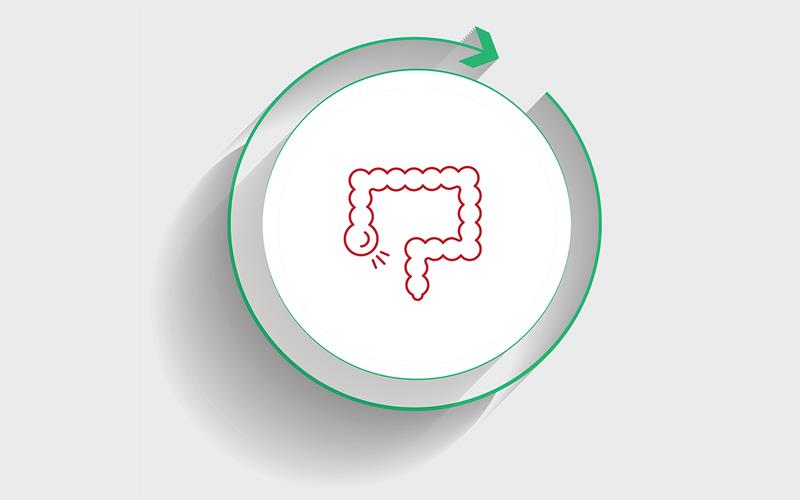Extended risankizumab treatment for CD may be needed in some patients





For some patients with Crohn’s disease (CD) who show no response to induction treatment with risankizumab, extending the treatment course is safe and improves clinical and endoscopic outcomes, as shown in a study.
In a cohort of 252 patients who did not achieve clinical response—defined as a ≥30-percent decrease in average daily stool frequency and/or a ≥30-percent decrease in average daily abdominal pain score—following 12 weeks of intravenous risankizumab induction therapy in the phase III ADVANCE and MOTIVATE studies, extending risankizumab treatment for another 12 weeks appeared beneficial. [Lancet 2022;399:2015-2030]
By week 24, clinical response was achieved in 76.2 percent of patients who received two additional dosing of subcutaneous risankizumab at 180 mg, in 63.7 percent of those who received two additional subcutaneous dosing at 360 mg, and in 62.3 percent of those who received three additional intravenous dosing at 1,200 mg. Clinical remission occurred in 43 percent, 45.1 percent, and 22.1 percent of patients, respectively. [Clin Gastroenterol Hepatol 2025;23:2012-2022.e6]
The corresponding rates of endoscopic response—defined as a >50-percent decrease in simple endoscopic score for CD (SES-CD) from baseline (or at least a 2-point reduction from baseline for patients with isolated ileal disease and a baseline SES-CD of 4)—by week 24 were 32.4 percent, 32.5 percent, and 40.5 percent. Endoscopic remission occurred in 25.1 percent, 18 percent, and 23.5 percent, respectively.
Prior failure of more than one biologic treatment and increased age were associated with reduced odds of achieving response after extended treatment.
For the analysis, the 252 patients who did not achieve clinical response with 12-week risankizumab induction therapy in ADVANCE and MOTIVATE were randomly assigned to receive 12-week extended treatment with 1,200-mg intravenous dosing at weeks 12, 16, and 20 (n=77); 180-mg subcutaneous dosing at weeks 12 and 20 (n=84); or 360-mg subcutaneous dosing at weeks 12 and 20 (n=91).
Response sustained
On further analysis, the investigators looked at patients who achieved clinical response at week 24 with subcutaneous risankizumab at 180 or 360 mg during extended treatment and continued on the same subcutaneous dose up to week 52 in the FORTIFY maintenance study. [Lancet 2022;399:2031-2046]
Clinical response was sustaine in most patients throughout the maintenance treatment, with a higher rate observed with the 360-mg dose vs the 180-mg dose at week 52 (69.7 percent vs 56.7 percent). A similar pattern of results was observed for clinical remission (54.5 percent vs 43.3 percent), endoscopic response (45.5 percent vs 36.7 percent), and endoscopic remission (42.4 percent vs 40 percent).
Taken together, these efficacy data suggest that despite nonresponse to induction therapy with risankizumab, delayed response and long-term clinical and endoscopic benefits can be achieved in some patients by extending the treatment course, according to the investigators.
No new safety concerns
In terms of safety, no new safety signals emerged with extended risankizumab treatment.
The exposure-adjusted event rates for treatment-emergent adverse events (TEAEs) at week 24 were generally similar across the subcutaneous 180 mg, subcutaneous 360 mg, and intravenous 1,200 mg groups (342.4 vs 327.2 vs 363.6 events per 100 person-years, respectively). The same was true for the rates of serious TEAEs (24.2 vs 18.5 vs 34.5 events per 100 person-years, respectively), or TEAEs leading to study discontinuation (3 vs 6.2 vs 3.1 events per 100 person-years, respectively).
For patients who received maintenance treatment with risankizumab in FORTIFY, the exposure-adjusted event rates for TEAEs at week 52 were numerically lower with the 360-mg dose than with the 180-mg dose (258.9 vs 479.8 events per 100 person-years).
AEs of special interest occurred infrequently with risankizumab induction and maintenance doses. The most frequently reported AEs of special interest were hypersensitivity and injection/infusion site reactions. One patient in the intravenous risankizumab 1,200 mg extended treatment group died due to exacerbated fistulizing CD and sepsis, which were not deemed to be related to study treatment.
Case for extending treatment
Describing the clinical implications of their study, the investigators highlighted a need to maximize the benefit of existing advanced treatments such as biologics for moderate to severe CD to delay disease progression, especially in patients who have failed prior therapies, given the limited treatment options in this population.
It is not fully established when and how to adjust or optimize therapy when a patient has a poor or lost response to newer drugs, but recent data on ustekinumab and adalimumab suggest that continuing treatment for an extended period can be effective in some patients who did not show an initial clinical response to induction treatment, they added. [Am J Gastroenterol 2024;119:1355-1364; Lancet 2022;399:2200-2211; N Engl J Med 2016;375:1946-1960]
“Considerations for extending treatment in patients beyond the standard 12-week induction period in clinical practice should include improvement or worsening of disease, biomarker levels (eg, high-sensitivity C-reactive protein and faecal calprotectin), and exposure to previous advanced therapies,” they said.